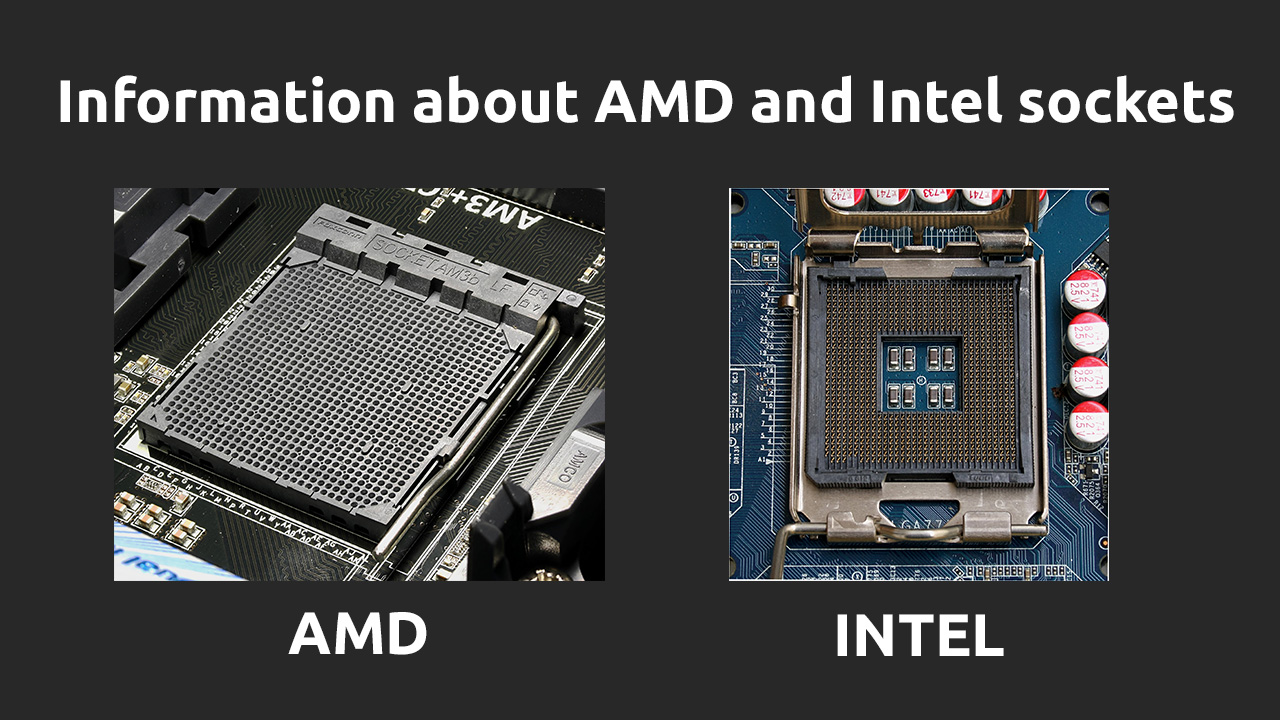Information about AMD and Intel sockets

A socket (CPU socket) is a connector of the central processor in the motherboard designed to install a processor in it.
Content
- History
- Socket Types
- Differences
- How to choose a socket
History
Initially, there were no sockets for processors on motherboards, and manufacturers simply soldered processors into boards. Because of this, upgrading computers was either insanely expensive or impossible. Over time, companies realized that it was not profitable for them to solder processors and thus sockets appeared. To put it simply, Using the connector instead of soldering the processor on the motherboard simplifies the replacement of the processor for upgrading or repairing the computer, and also significantly reduces the cost of the motherboard. That's why they were created.
Socket Differences
Currently, there are many types of sockets, but they are divided into two categories: AMD and Intel.
The key difference between these two categories is the following - AMD has legs on the processor, while Intel does not.
Also, a very important aspect is that when updating Intel processors, you most often have to change the motherboard, because old motherboards may not be suitable for new processors, while AMD has an excellent adaptation of new processors to older mothers. (But there are also nuances here, which you can read about below.)
Of the other differences, this is of course the price of motherboards (Intel usually has a higher price).
Socket Types
As previously mentioned, sockets belong to two categories - AMD and Intel, but there are many types of sockets. The list will be given below, but it will include only sockets starting from 2008 (It makes no sense to take older sockets).
AMD Sockets
Sockets for AMD are not updated so often, so it is quite easy to update the system. Don't forget to check if your motherboard supports the processor you are going to buy. (It should be done on the official website)
- The AM3 socket, released in 2009, which will later be upgraded to AM3+, was developed with the idea of assembling inexpensive or high-performance systems, supports the DDR3 memory format. All processors released for the AM3 socket are fully compatible with the AM3+ connector
- AM3+ - Released in 2011 and is designed for servers or expensive and high-performance computers. Architecturally, processors for socket AM3+ are suitable for socket AM3 but are not supported by motherboards.
- AM4 - Released in 2016 is designed for processors based on the ZEN, ZEN+ and ZEN2 architecture. Declared support for RAM standard DDR4.
- AM5(LGA 1718) - Released in 2022, designed to replace AM4, designed for Ryzen 7000 processors. The processors no longer have legs, now the socket looks like for Intel processors
There are also other types of sockets designed for Workstations, Office work, but we have mentioned here those that are used specifically for PCs.
Intel Sockets
Intel sockets are updated very often, As part of its penultimate series of processors, as many as three new sockets have appeared, and they are completely incompatible. For some, this is good, but for others it is not because we can observe an increase in performance for each series of processors, but it is bad because updating will be quite expensive.
- LGA1156 - the successor of the LGA 775 processor connector for desktop systems and the LGA 771 processor connector for mid- and entry-level servers from Intel was released in 2009.
- LGA1155 - Processor connector for Intel processors using Sandy Bridge microarchitecture was released in 2011. Sandy Bridge officially supports memory up to DDR3-1333, but in practice they successfully worked with memory at speeds up to DDR3-2133.
- LGA1150 - Released in 2013. LGA 1150 is designed as a replacement for LGA 1155 (Socket H2). processor connector for Intel processors of the Haswell microarchitecture and its successor Broadwell. It was supported until the end of 2014. Supports DDR3 memory
- LGA 1151 - A connector for Intel processors was released in 2015 as a replacement for the LGA 1150 connector. Supports DDR3 and DDR4 memory in some motherboards. However, it cannot support both types of memory at the same time, so you can connect either only DDR3 or DDR4.
- LGA 1200 is a processor connector released in 2020 for Intel processors of the Comet Lake and Rocket Lake families. The LGA 1200 is designed as a replacement for the LGA 1151 connector (Socket H4) Supports DDR4 memory only.
- LGA 1700 is a processor connector released in 2021 for Intel's 12th and 13th generation processors. Supported DDR5 memory The new socket supports processors with the Alder Lake microarchitecture.
How to choose a socket?
Choosing a socket is actually quite a simple matter. To do this, you will need to answer the following questions:
- Are you going to build a computer for the office, shooting a video, or a server?
- What PCI-E slots do you need?
- What type of RAM will be used?
- How often are you going to update?
The first answer
- If your answer is for the office, then old sockets like AM3+ or LGA1155 will also suit you.
- If you are building a gaming PC or for shooting video, choose the AM4 - AM5 chipset or LGA 1151 - LGA 1200
- If you are building a server, then use sockets as for a gaming PC to ensure more stable operation.
Second answer
- If you are interested in PCI-E 3.0 slots, then use AM3+ or LGA1155 sockets.
- If the slots should be newer, then AM4 - AM5 or LGA 1151 - LGA 1200
The third answer
- For DDR3 type memory, AM3 - AM3+ or LGA1155 sockets should be used.
- For DDR4, use sockets AM4 or LGA 1151 - LGA 1200
- For DDR5, AM5 or LGA 1700 sockets should be used
The fourth answer
- If you are going to update the system frequently, but do not want to spend a lot of money, then you should use AMD sockets
- If you are going to update rarely and performance is important to you, then use Intel sockets
Conclusion
In today's article, you have received information about sockets, their types and types. You found out what two types they are divided into and what exactly should be taken into account when choosing them. In the future, we will analyze video cards, processors, and more.

